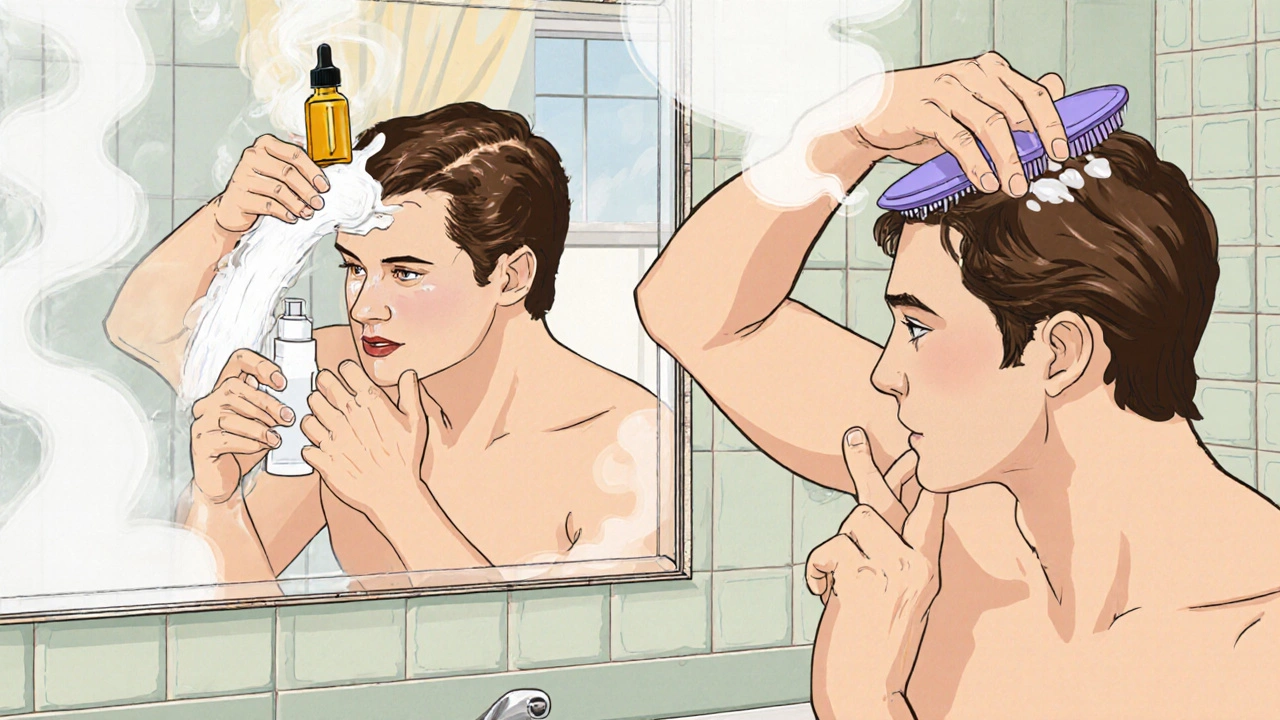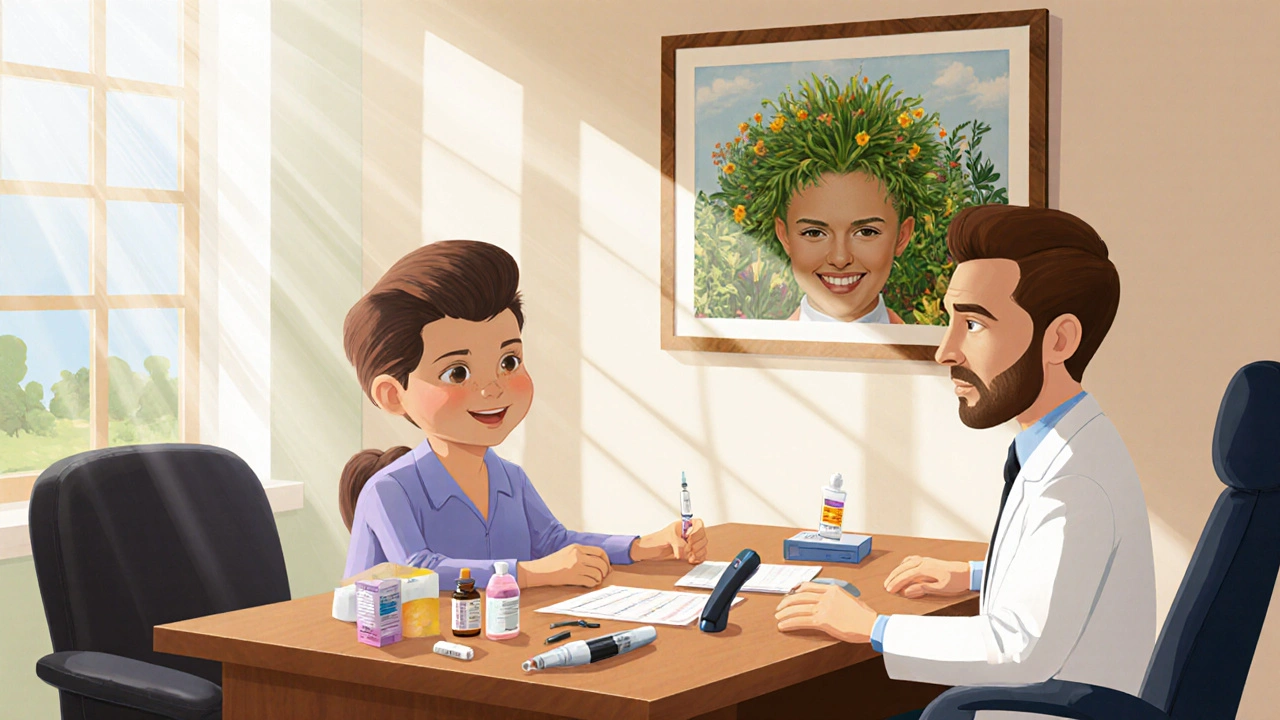How to Keep Your Scalp Healthy and Stop Hair Loss as You Age

Personalized Scalp Care Calculator
Your Scalp Profile
Lifestyle Factors
Seeing more strands on your pillow or noticing a thinner crown can feel alarming, especially as the years add up. The good news? A lot of the change is within your control. By treating your scalp like a garden-regular watering, occasional pruning, and protecting it from pests-you can maintain a prevent hair loss routine that works for most adults.
Key Takeaways
- Balance sebum production with gentle cleansing and occasional exfoliation.
- Boost blood flow through massage, low‑level laser therapy, or regular exercise.
- Support follicles with nutrients like biotin, vitamin D, and sufficient protein.
- Address hormonal and stress‑related triggers early to slow down follicle miniaturization.
- Choose evidence‑based professional treatments only after mastering a solid home‑care routine.
Understanding Scalp Health
Scalp Health refers to the condition of the skin covering the head, including oil balance, moisture level, and blood circulation is the foundation for strong, resilient hair. When the scalp environment stays balanced, hair follicles receive the oxygen and nutrients they need to produce thick strands. Problems like excess oil, dryness, or inflammation create a hostile setting that accelerates shedding.
Why Hair Loss Increases with Age
Age doesn’t magically yank hair out of your follicles; it shifts the biology that keeps them alive. Here are the most common culprits:
- Androgenetic Alopecia a hereditary pattern‑type hair loss driven by dihydrotestosterone (DHT) that shrinks follicles over time.
- Follicle Miniaturization the process where each hair shaft becomes finer and shorter, leading to visible thinning.
- Hormonal Changes fluctuations in estrogen, testosterone, and thyroid hormones that affect the hair growth cycle, especially during menopause or menopause‑related testosterone shifts.
- Reduced Sebum Production as you age, the scalp can become drier, compromising the protective lipid barrier.
- Chronic stress, which raises cortisol and can push follicles into a resting phase.

Build a Daily Scalp‑Care Routine
Think of your routine as a three‑step cleanse‑nourish‑stimulate cycle.
- Gentle Cleansing: Use a sulfate‑free shampoo formulated for your scalp type (oily, dry, or normal). Wet hair, apply a pea‑sized amount, massage for 60 seconds, then rinse with lukewarm water. Over‑washing strips natural oils, while under‑washing leads to buildup.
- Targeted Treatment: After towel‑drying, apply a leave‑in serum that contains Biotin a B‑vitamin that supports keratin production and follicle strength or Vitamin D helps regulate the hair growth cycle and immune response on the scalp. Focus on the crown and any thinning zones.
- Scalp Massage: Spend 2-3 minutes daily using fingertips or a silicone brush. Move in circular motions to increase blood flow. For an extra boost, alternate with a low‑level laser therapy device (see the comparison table below).
Nutrition & Lifestyle Habits That Support the Scalp
What you eat and how you live plays a huge role. Incorporate these evidence‑backed habits:
- Consume 1.2‑2.0 g of protein per kilogram of body weight daily. Lean meats, legumes, and dairy provide the amino acids needed for keratin.
- Include omega‑3 rich foods (salmon, walnuts, flaxseed) to reduce inflammation and improve sebum quality.
- Take a daily Biotin supplement at 30-45 µg, the recommended intake for adults if your diet lacks it.
- Get at least 600 IU of vitamin D each day, either from sunlight exposure (10‑15 minutes mid‑day) or fortified foods.
- Stay hydrated-aim for 2‑2.5 L of water; hydration helps maintain scalp moisture.
- Practice stress‑reduction techniques: yoga, meditation, or regular cardio can lower cortisol, which otherwise stalls hair growth.
Professional Treatments: When Home Care Isn’t Enough
If you’ve followed a solid routine for three months and still see rapid thinning, it might be time to explore clinically proven options. Below is a quick side‑by‑side look.
| Treatment | How It Works | Typical Sessions | Evidence Grade |
|---|---|---|---|
| Minoxidil 5% Topical | Vasodilator that prolongs the anagen (growth) phase | Twice daily, indefinite | Strong A |
| Finasteride 1 mg Oral | DHT blocker that reduces follicle miniaturization | Once daily, indefinite | Strong B |
| Platelet‑Rich Plasma (PRP) | Injects growth‑factor‑rich plasma to stimulate follicles | 3‑4 sessions, 4‑6 weeks apart | Moderate C |
| Low‑Level Laser Therapy (LLLT) | Red light (630‑660 nm) boosts cellular metabolism | 3‑5 min per session, 3‑4×/week | Moderate B |
| Hair Transplant (FUE) | Redistributes healthy donor follicles to balding zones | 1‑2‑day procedure, recovery 7‑10 days | Strong A |
Before opting for any prescription or procedure, consult a dermatologist or trichologist. They can run a scalp‑microscope exam, blood panel, and hormonal assessment to pinpoint the exact cause.

Common Myths That Sabotage Scalp Care
- Myth: Shaving your head makes hair grow back thicker.
Fact: Shaving only cuts the shaft; it doesn’t affect follicle size. - Myth: Daily hair‑drying destroys hair.
Fact: Low‑heat settings are safe; the real risk is excessive tension from tight hairstyles. - Myth: All oils clog pores.
Fact: Non‑comedogenic oils like jojoba mimic sebum and can actually balance oil production.
Quick Daily Checklist
- Wash with sulfate‑free shampoo (once‑twice daily).
- Apply a biotin‑rich serum to the crown.
- Massage scalp for 2 minutes.
- Take daily biotin and vitamin D supplements if diet is lacking.
- Stay hydrated and eat protein‑rich meals.
- Practice a stress‑relief habit (e.g., 10‑minute meditation).
Frequently Asked Questions
How often should I wash my scalp to keep it healthy?
Most adults benefit from washing 1‑2 times per day with a gentle, sulfate‑free formula. Over‑washing strips natural oils, while under‑washing leads to buildup that can irritate follicles.
Can diet really affect hair loss?
Yes. Hair is mostly protein, so insufficient protein or essential nutrients like iron, zinc, biotin, and vitamin D can cause thinning. A balanced diet rich in lean meats, fish, legumes, nuts, and leafy greens supports robust growth.
Is it safe to use minoxidil after the age of 60?
Minoxidil is generally safe for older adults, but skin sensitivity can increase. Start with a half‑dose and monitor for irritation. A dermatologist can confirm suitability.
Do low‑level laser devices really work?
Clinical trials show modest improvement in hair density after consistent use (3‑4 sessions per week for 6‑12 months). They are safe, non‑invasive, and work best alongside topical treatments.
What’s the best way to treat dandruff without damaging hair?
Choose a gentle anti‑dandruff shampoo with zinc pyrithione or selenium sulfide, use it twice a week, and follow with a hydrating conditioner to keep the hair shaft moisturized.
Keeping your scalp in top shape isn’t a one‑time fix; it’s a habit that evolves with your age, lifestyle, and health. Stick to the routine, stay informed, and don’t hesitate to seek professional advice when needed. Your hair will thank you for the extra TLC.
Sameer Khan
October 22, 2025 AT 17:48Understanding scalp health requires an appreciation of the integumentary equilibrium that governs follicular kinetics.
When sebum synthesis aligns with epidermal hydration, the microenvironment sustains keratinocyte proliferation and angiogenic flux.
Conversely, dysregulated lipid output instigates inflammatory mediators that accelerate telogen induction.
The paradigm of a “garden” scalp underscores the necessity of periodic mechanical stimulation to augment perfusion.
Empirical data indicate that a two‑minute circular massage augments cutaneous blood flow by up to 30 %.
Nutritional substrates, notably biotin, vitamin D, and essential amino acids, function as co‑factors in the synthesis of keratin filaments.
Protein intake calibrated to 1.5 g·kg⁻¹ mitigates catabolic degradation of hair shafts.
Omega‑3 polyunsaturated fatty acids modulate eicosanoid pathways, thereby attenuating sebaceous hyperactivity.
Hormonal homeostasis, particularly the balance of dihydrotestosterone and estrogenic compounds, orchestrates the anagen-to‑catagen transition.
Elevated cortisol, a by‑product of chronic stress, diverts glucocorticoid receptors away from follicular niches, precipitating premature rest phases.
Low‑level laser therapy delivers photobiomodulation at 630–660 nm, catalyzing mitochondrial ATP synthesis within dermal papilla cells.
Clinical trials have documented a modest increase in hair density after 12 weeks of tri‑weekly exposure.
Topical minoxidil operates as a vasodilator, extending the anagen duration by sustaining perifollicular circulation.
Finasteride antagonizes 5α‑reductase, thereby curtailing dihydrotestosterone synthesis and preserving follicular caliber.
Collectively, a regimented protocol integrating gentle cleansing, nutrient optimization, mechanical stimulation, and evidence‑based therapeutics constitutes a robust strategy for preserving scalp integrity across the lifespan.
Vin Alls
November 14, 2025 AT 20:22What a well‑rounded roadmap! I love the way you blend science with simple, doable steps. A splash of sulfate‑free shampoo, a dash of biotin serum, and a few minutes of scalp‑massage can feel like a spa day for your head. Add some salmon or walnuts to your plate and you’re basically feeding your follicles a gourmet dinner. Keep the routine consistent and you’ll likely see a noticeable uptick in thickness within a couple of months.
Tiffany Davis
December 7, 2025 AT 23:55The checklist you provided is practical and easy to follow. I especially appreciate the emphasis on hydration and stress management, which are often overlooked. Using a non‑comedogenic oil like jojoba can help balance sebum without clogging pores. Overall, a solid foundation for anyone looking to maintain scalp health.